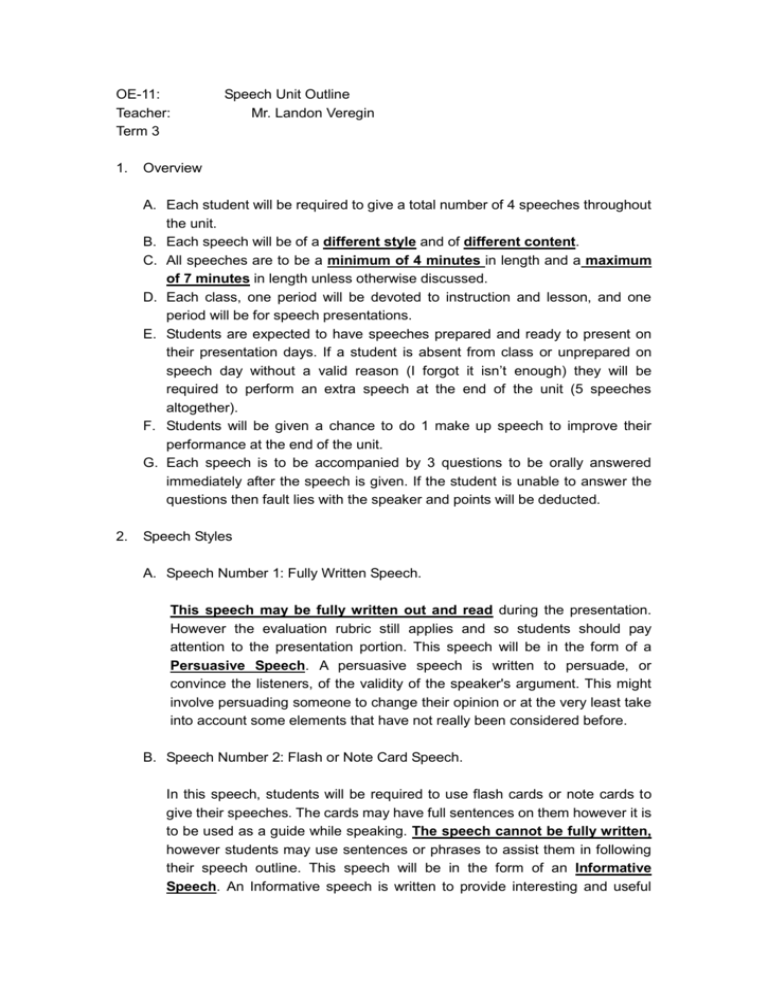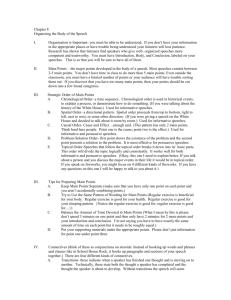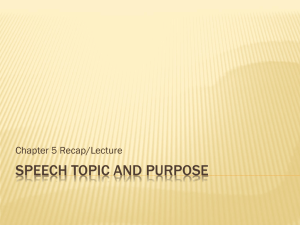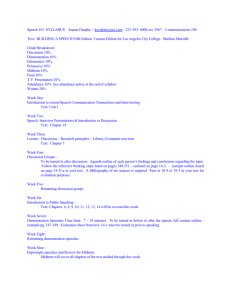Speech Unit Overview
advertisement

OE-11: Teacher: Term 3 1. Speech Unit Outline Mr. Landon Veregin Overview A. Each student will be required to give a total number of 4 speeches throughout the unit. B. Each speech will be of a different style and of different content. C. All speeches are to be a minimum of 4 minutes in length and a maximum of 7 minutes in length unless otherwise discussed. D. Each class, one period will be devoted to instruction and lesson, and one period will be for speech presentations. E. Students are expected to have speeches prepared and ready to present on their presentation days. If a student is absent from class or unprepared on speech day without a valid reason (I forgot it isn’t enough) they will be required to perform an extra speech at the end of the unit (5 speeches altogether). F. Students will be given a chance to do 1 make up speech to improve their performance at the end of the unit. G. Each speech is to be accompanied by 3 questions to be orally answered immediately after the speech is given. If the student is unable to answer the questions then fault lies with the speaker and points will be deducted. 2. Speech Styles A. Speech Number 1: Fully Written Speech. This speech may be fully written out and read during the presentation. However the evaluation rubric still applies and so students should pay attention to the presentation portion. This speech will be in the form of a Persuasive Speech. A persuasive speech is written to persuade, or convince the listeners, of the validity of the speaker's argument. This might involve persuading someone to change their opinion or at the very least take into account some elements that have not really been considered before. B. Speech Number 2: Flash or Note Card Speech. In this speech, students will be required to use flash cards or note cards to give their speeches. The cards may have full sentences on them however it is to be used as a guide while speaking. The speech cannot be fully written, however students may use sentences or phrases to assist them in following their speech outline. This speech will be in the form of an Informative Speech. An Informative speech is written to provide interesting and useful information to increase the knowledge of your audience. This might involve providing information about a person, an animal or an object. It might centre around information regarding a process, a 'How to' speech e.g. How to Surf the Internet. Informative speeches can be focused on describing an event like 'Visiting an exhibition in Shanghai'. And finally informative speeches can be about ideas or concepts like 'Aliens' or 'What happened to the Dinosaurs'. C. Speech Number 3: Props, Pamphlets or Diagrams. This will be a Demonstration speech. For this speech, students will be required to use a procedural prop (e.g. a toy, an electronic device, a tool etc.), an instructional pamphlet (e.g. a folded paper explaining the steps involved in using a device) or a diagram (e.g. a poster showing the steps involved in using a device) to show how to use something. Students may use note cards while giving this speech but are encouraged to use their props, pamphlets or diagrams as a guide throughout their speech. D. Speech Number 4: Power Point Presentation This speech allows students the choice between an inspirational speech, an introduction speech and a motivational speech. Students may not use any written notes or cards. The Power Point presentation is the only tool being used. Below are definitions of the 3 different kinds of speeches: Inspirational Speech: An Inspirational speech is written to persuade, or convince the listeners, that they can succeed. This might involve relating optimistic and uplifting stories, or anecdotes, based on faith or real life situations taken from the lives of ordinary or famous people from history, sports, politics and the business world. The objective of an inspirational speech is to provide the listener with the desire and confidence to pursue difficult goals to maximize their own potential. Introduction Speech: An Introduction speech is an opener written to introduce the speaker and the subject they will be talking about. It is helpful to provide the audience with details of the speaker's background and achievements in order to establish the speaker’s credibility with respect to the topic. Students will choose a famous person and a speech they have given, then write an introduction speech as if they were introducing them at the time that speech was taking place. Motivational Speech: A Motivational speech is written to persuade, or convince the listeners, to take action to improve. This might involve convincing someone that increased effort and energy will lead to improved performance. A motivational speech should provide an outline of the problem and the benefits of change which will require elements of conviction, direction, intensity and persistence from the speaker in their efforts to persuade the listener to take a pro-active approach. 3. Speech Schedule TBA Marking Rubric Content: The points you discuss in your speech and the organization. Speaking: Pronunciation, Fluency, Clarity and pace. Body Language: Eye contact, posture, hand gestures Written Tool: Speech outline written well or not.






